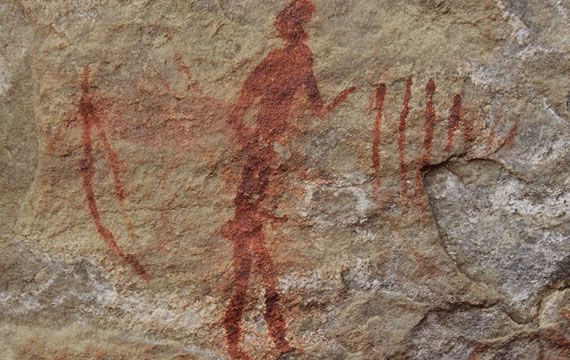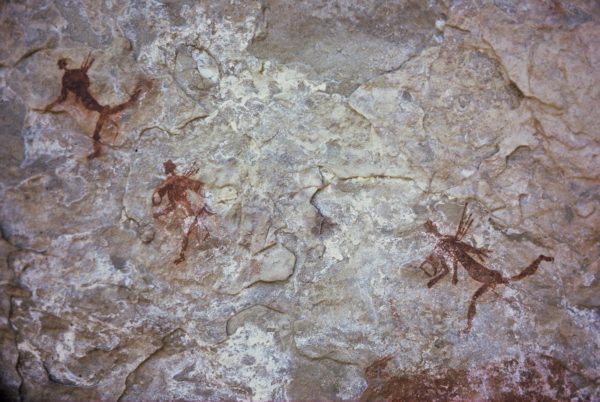GRADE: E
TIME: 2½ hours.
DISTANCE: 4 km.
TERRAIN: Undulating path with moderate slopes. Only done with a hotel guide as it is easy to miss the paintings.
The Bushman paintings are the most accessible in the Drakensberg, and are the main focus of this walk. Take the back route out of The Cavern, past the football field and dams, continuing up the Sugar Loaf path. Avoid the turn-off to the aerial. Go straight towards the escarpment past the first small plateau. Watch on the left for a huge flat “white” rock. Align this rock with another big “white” rock about 400 m away to the left and slightly higher. You will then see an “orange” rock, slightly above the second white rock. This orange rock is just above the level of the large second plateau. Now follow the path until reaching a gate on the left. Go through the gate and this path takes you to the paintings on the north side of the orange rock. These paintings are deteriorating with age; please do not touch them, nor splash them with water.
Bushman history and culture
Seven hundred years ago, and for many thousand years before that, the Bushmen were the only humans in South Africa. They lived by hunting and gathering. They had no domestic animals, nor cultivated crops, and very few possessions at all. They must have been semi-nomadic – following movements of large animals if food became scarce. But in the Drakensberg it may be that some Bushmen lived permanently because of the good shelters here. Much of what we know about them comes from their paintings. These depict scenes of human activity, animal portraits, and other visions that must have been part of their religion. All of the Drakensberg paintings are on Cave Sandstone, a rock custom‑built for the purpose. The sandstone is porous so that paint applied will sink in and “grip”.
Nguni (Black) people spread down to South Africa about 700 years ago, bringing cattle, crops and the idea of ownership – including land. The Bushmen did not understand this, so fighting began. Now no Bushmen are left here. The last recorded sighting of a Berg Bushman was in 1871. Some survive in the Kalahari, but these are relatives who have never painted.
The copy of the Lone Rock painting near The Cavern games room is worth examining before or after the walk – weather might decide which. This copy has more detail than the original painting – like all Bushman paintings the original is gradually fading away.
Bushman art has a distinctive style. It is not exactly true to life but uses “artistic licence”, in the way that a modern newspaper cartoonist does, exaggerating special characters to add emphasis. So the people have extra-enlarged buttocks (Bushmen really do have relatively bigger buttocks than other people); the angle of the legs of the hunters tells that they were super-speed runners; and eland pictures all show the typical huge neck and shoulders, and to emphasise the point the legs are made small and thin.
Even so, we can see that three different artists are represented in this painting. This is not a single painting but was added to at intervals, perhaps spanning several years. There seems to be no respect for a previous artist’s work: newer parts of the painting overlap older. “Over-painting” is typical of Bushman paintings elsewhere. One explanation is that there were only a few really good rock walls and that the artists competed with each other for space.
Three different antelopes are illustrated at Lone Rock. The eland is easy, look at the body shape. Note that we cannot use body size alone to identify animals because different artists used different scales. The other two antelopes are thin in build. The grey rhebuck is shown with its long ears and snout exaggerated just that little bit, surely to distinguish it from a mountain reedbuck.
The depiction of fighting other Bushmen here is typical of many other paintings too. This seems strange in a people generally supposed to be at peace with everything. So we can deduce that life was not all peace and harmony, man has always fought over anything when it is in short supply, here perhaps the best rock shelter.
The little bows seem too small to do much damage. If painted true to life size this means that they would only be effective with the use of poisoned arrows. As it happens we do think that Bushmen bows were small because some have been saved from those days. Nobody else used poisoned arrows, and the Bushmen’s enemies thought this was an “unfair” way of fighting.
Which hand did the bushman use to paint with? Left-handedness in people today is not that common – about one in seven, but in Bushmen at least half the work (both here and everywhere else) is by left-handed artists. The way to detect this is to see which way they painted the animal’s face. A right-handed person draws an animal starting with its nose facing left, carrying on towards the tail; it’s the same way we write. Left-handed people usually start a drawing on the right. Of significance is that a high proportion of modern artistic people are left-handed. Were most Bushmen naturally artistic?
The materials used for the paint were charcoal, ochraceous (yellow-brown) clay soil, iron-rich rocks, bird droppings and plant juices. Green and blue could not be produced from any mixture of these, so were never used. Egg-white of wild birds was used to bind all the materials together.



The path info on this page and on the printed map are outdated. To reach lone rock simply follow the signs for sugar loaf, then along the way you will see signs with the combo cannibal cave/Lone rock to follow. The digital maps don’t tell you exactly where the lone rock is but it is difficult to miss. It is litteraly a big lone rock almost in the middle of the path. The painting are easy to see. You don’t need a guide to get there. After the paintings, you can either turn back or continue to cannibal cavern then return to the resort by the steep route and TV ridge. The whole ride took me 3h30 minutes at a slow pace.
Thanks so much for your feedback, Caroline.
We appreciate you taking the time to point this out and I will have a look at the detail.
In more recent years, the site has become more obvious, with a rock wall, but a number of folk still battle to find them.
And, we think it is best that hikers are accompanied so that the guide can ensure that no-one writes or splashes water on the paintings.
Best wishes,
Megan